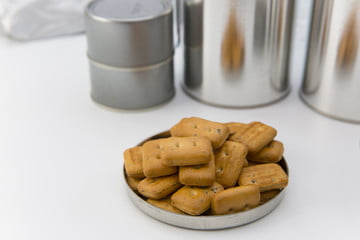
Hardtack is a type of hard, dry bread that has been eaten by soldiers and sailors throughout history as a means of sustenance. It is popular among campers and survivalists because it can last for years if stored properly.
Fortunately, it’s also an extremely easy recipe and you can make your own traditional hardtack with just a few ingredients. You can also add a few spices and flavorings for a much better-tasting hardtack than people ate years ago. Tailoring the flavor of the hardtack to meet your personal preference will definitely make this cracker easier to eat if you are ever in a SHTF situation.
You only need three ingredients to make hardtack:
2 cups (256 g) of flour
1 cup (240 mL) of water
2 tsp (11.38 g) of salt (optional)
Preheat your oven to 375 °F (191 °C). The prep time for hardtack is fast, so preheat your oven first. By the time the oven is ready, you can carry out all the prep work. Pour the flour into a mixing bowl. (Any type of flour will work for this recipe, but hardtack made from white flour lasts the longest). Different flours like whole wheat or rye produce hardtack that won’t last as long as they are more nutrient-dense and will spoil quicker. Gradually pour the water into the flour a little at a time and knead the dough. Using both hands, work the dough with your hands until it reaches a uniform consistency. Add your salt and other spices if you have decided to flavor your hardtack.
Sprinkle some flour and use a rolling pin to roll out the hardtack dough. Hardtack is generally cut into large squares. But do whatever you want here. Poke holes in each cracker. Again, this is really up to you and the number of holes will depend on the size of the cracker you cut. Place the crackers on an ungreased cookie sheet ensuring they don’t overlap. Bake for 30 minutes on each side until they are a golden brown color. Allow the crackers to cool, then store them with your survival food, or toss some into your vehicle emergency bag. If properly sealed, they will stay good for years. Vacuum sealing will also help the hardtack last longer.
Try making hardtack if you’d like and see how long you can get it to last! It’s a great option for preppers for who want to beef up their food supply.










0 Comments